Acer saccharinum
| Acer saccharinum | |
|---|---|
.jpg) | |
| Scientific classification | |
| Kingdom: | Plantae |
| (unranked): | Angiosperms |
| (unranked): | Eudicots |
| (unranked): | Rosids |
| Order: | Sapindales |
| Family: | Sapindaceae[1] |
| Genus: | Acer |
| Species: | A. saccharinum |
| Binomial name | |
| Acer saccharinum L. 1753 | |
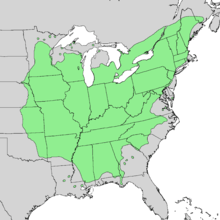 | |
| Natural range of Acer saccharinum | |
| Synonyms[2] | |
|
List
| |
Acer saccharinum, commonly known as silver maple,[3] creek maple, silverleaf maple,[3] soft maple,[3] water maple,[3] swamp maple,[3] or white maple[3]—is a species of maple native to eastern and central North America in the eastern United States and Canada. It is one of the most common trees in the United States.
Description
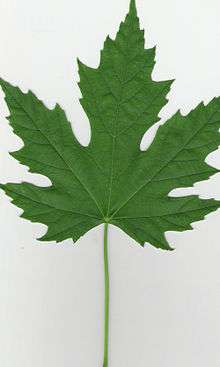
The silver maple tree is a relatively fast-growing deciduous tree, commonly reaching a height of 15–25 m (49–82 ft), exceptionally 35 m (115 ft). Its spread will generally be 11–15 m (36–49 ft) wide. A 10-year-old sapling will stand about 8 m (26 ft) tall. It is often found along waterways and in wetlands, leading to the colloquial name "water maple". It is a highly adaptable tree, although it has higher sunlight requirements than other maple trees.

The leaves are simple and palmately veined, 8–16 cm long and 6–12 cm broad, with deep angular notches between the five lobes. The 5–12 cm long, slender stalks of the leaves mean that even a light breeze can produce a striking effect as the downy silver undersides of the leaves are exposed. The autumn color is less pronounced than in many maples, generally ending up a pale yellow, although some specimens can produce a more brilliant yellow and even orange and red colorations. The tree has a tendency to color and drop its leaves slightly earlier in autumn than other maples.
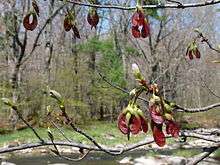
The flowers are in dense clusters, produced before the leaves in early spring,[4] with the seeds maturing in early summer. The fruit are samaras, each containing a single seed, and winged, in pairs, small (5–10 mm diameter), the wing about 3–5 cm long. The fruit are the largest of any native maple. Although the wings provide for some transport by air, the fruit are heavy and are also transported by water. Silver Maple and its close cousin Red Maple are the only Acer species which produce their fruit crop in spring instead of fall. The seeds of both trees have no epigeal dormancy and will germinate immediately.
On mature trunks, the bark is gray and shaggy. On branches and young trunks, the bark is smooth and silvery gray.
Cultivation and uses
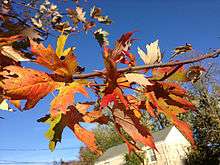
Wildlife uses the silver maple in various ways. In many parts of the eastern U.S., the large rounded buds are one of the primary food sources for squirrels during the spring, after many acorns and nuts have sprouted and the squirrels' food is scarce. The seeds are also a food source for squirrels, chipmunks and birds. The bark can be eaten by beaver and deer. The trunks tend to produce cavities, which can shelter squirrels, raccoons, opossums, owls and woodpeckers.[5]
Native Americans used the sap of wild trees to make sugar, as medicine, and in bread. They used the wood to make baskets and furniture.[5] An infusion of bark removed from the south side of the tree is used by the Mohegan for cough medicine.[6]
Today the wood can be used as pulp for making paper.[7] Lumber from the tree is used in furniture, cabinets, flooring, musical instruments, crates and tool handles, because it is light and easily worked. Because of the silver maple's fast growth, it is being researched as a potential source of biofuels.[5] Silver maple produces a sweet sap, but it is generally not used by commercial sugarmakers because its sugar content is lower than in other maple species.[8]
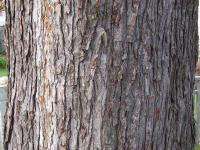
The silver maple is often planted as an ornamental tree because of its rapid growth and ease of propagation and transplanting. It is highly tolerant of urban situations, and is frequently planted next to streets. However, its quick growth produces brittle wood, and is commonly damaged in storms. The silver maple's root system is shallow and fibrous, and easily invades septic fields and old drain pipes; it can also crack sidewalks and foundations. It is a vigorous resprouter, and if not pruned, will often grow with multiple trunks. Although it naturally is found near water, it can grow on drier ground if planted there. In ideal natural conditions, A. saccharinum may live up 130 years, but in urban environments often 80 or less.
Following WWII, silver maples were commonly used as a landscaping and street tree in suburban housing developments and cities due to their rapid growth, especially as a replacement for the blighted American Elm. However, they fell out of favor for this purpose because of brittle wood, unattractive form when not pruned or trained, and tendency to produce large numbers of volunteer seedlings, and nowadays it is much less popular for this purpose to the point where some towns and cities banned its use as a street tree.
It is also commonly cultivated outside its native range, showing tolerance of a wide range of climates, growing successfully as far north as central Norway and south to Orlando, Florida. It can thrive in a Mediterranean climate, as at Jerusalem and Los Angeles, if summer water is provided. It is also grown in temperate parts of the Southern Hemisphere: Argentina, Uruguay, Venezuela, the southern states of Brazil (as well as in a few low-temperature locations within the states of São Paulo and Minas Gerais).
The silver maple is closely related to the red maple (Acer rubrum), and can hybridise with it. The hybrid variation is known as the Freeman maple (Acer x freemanii). The Freeman maple is a popular ornamental tree in parks and large gardens, combining the fast growth of silver maple with the less brittle wood, less invasive roots, and the beautiful bright red fall foliage of the red maple.
The silver maple is the favoured host of the parasitic cottony maple scale. and the maple bladder gall mite Vasates quadripedes.[9]
Cultural references
In the English Christmas carol, "Wassail, Wassail All Over the Town", the "white maple" in "Our bowl, it is made of the white maple tree" refers not to the silver (white) maple, but the wood of the sycamore maple, Acer pseudoplatanus.
References
- ↑ Stevens, P. F. (2001 onwards). Angiosperm Phylogeny Website. Version 9, June 2008 [and more or less continuously updated since]. http://www.mobot.org/MOBOT/research/APweb/.
- ↑ The Plant List, Acer saccharinum L.
- 1 2 3 4 5 6 Gabriel, William J. (1990). "Acer saccharinum". In Burns, Russell M.; Honkala, Barbara H. Hardwoods. Silvics of North America. Washington, D.C.: United States Forest Service (USFS), United States Department of Agriculture (USDA). 2 – via Northeastern Area State and Private Forestry (www.na.fs.fed.us).
- ↑ "Jepson Flora Project".
- 1 2 3 Geyer, W. A.; J. Dickerson; J. M. Row (2010). "Plant Guide for Silver Maple (Acer saccharinum L.)" (PDF). Plant Guide. Manhattan, KS: U.S. Department of Agriculture - Natural Resources Conservation Service. Retrieved 2012-10-10.
- ↑ Tantaquidgeon, Gladys 1928 Mohegan Medicinal Practices, Weather-Lore and Superstitions. SI-BAE Annual Report #43: 264-270 (p. 269)
- ↑ "Silver Maple, Acer saccharinum L.". Maple Field Guide. MapleInfo.org. Retrieved 2012-10-10.
- ↑ Geyer, W. A.; J. Dickerson; J. M. Row (2010). "Plant Guide for Silver Maple (Acer saccharinum L.)" (PDF). USDA- Natural Resources Conservation Service.
- ↑ Redfern M.; Shirley P.R.; Bloxham M. (2011). British Plant Galls (Second Edition). Preston Montford: Field Studies Council. p. 23. ISBN 978 1 85153 284 1.
External links
- United States Department of Agriculture Plants Profile: Acer saccharinum
- University of Connecticut Plant Database: Silver Maple
- Trees of Western North Carolina: Silver Maple
- Acer saccharinum images from Vanderbilt University
- Trees of Western North Carolina: Silver
- Portrait of the Earth, Winter ID pictures
- Plant Maps, Interactive Distribution Map for Acer saccharinum
- photo of herbarium specimen at Missouri Botanical Garden, collected in Missouri in 1989
| Wikimedia Commons has media related to Acer saccharinum. |